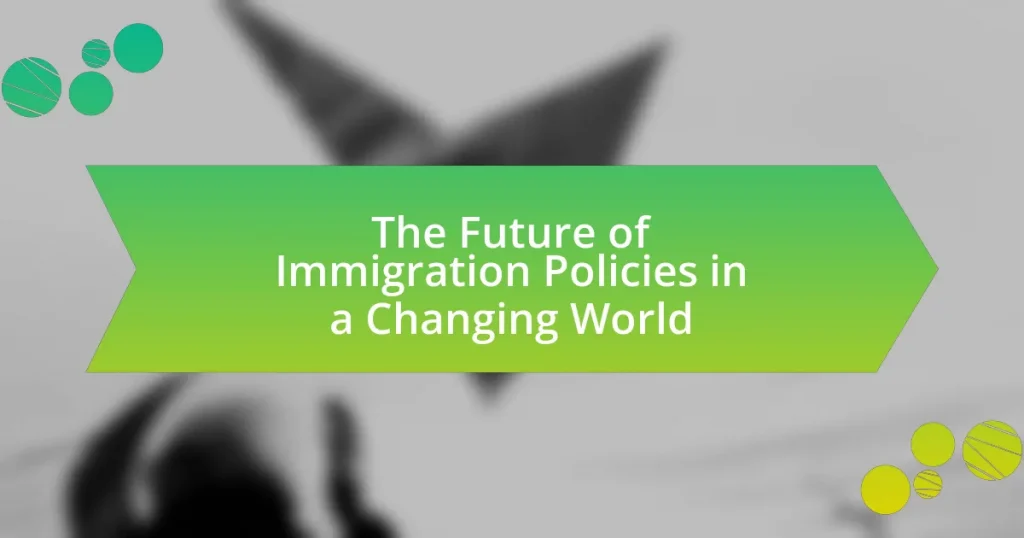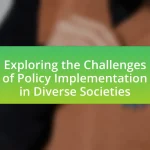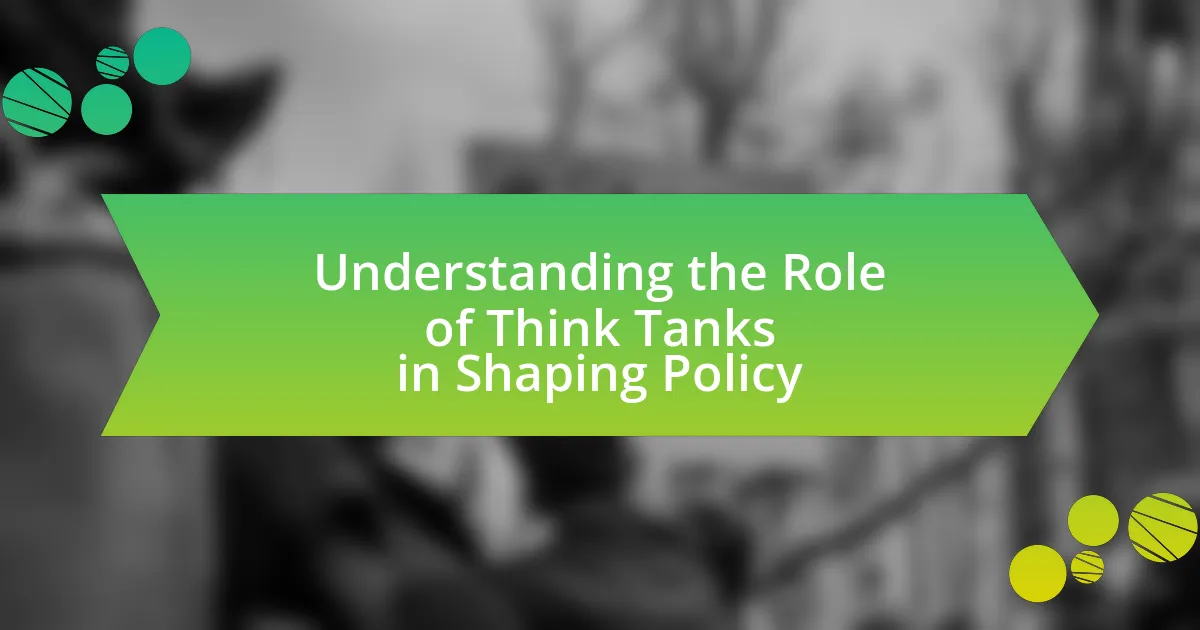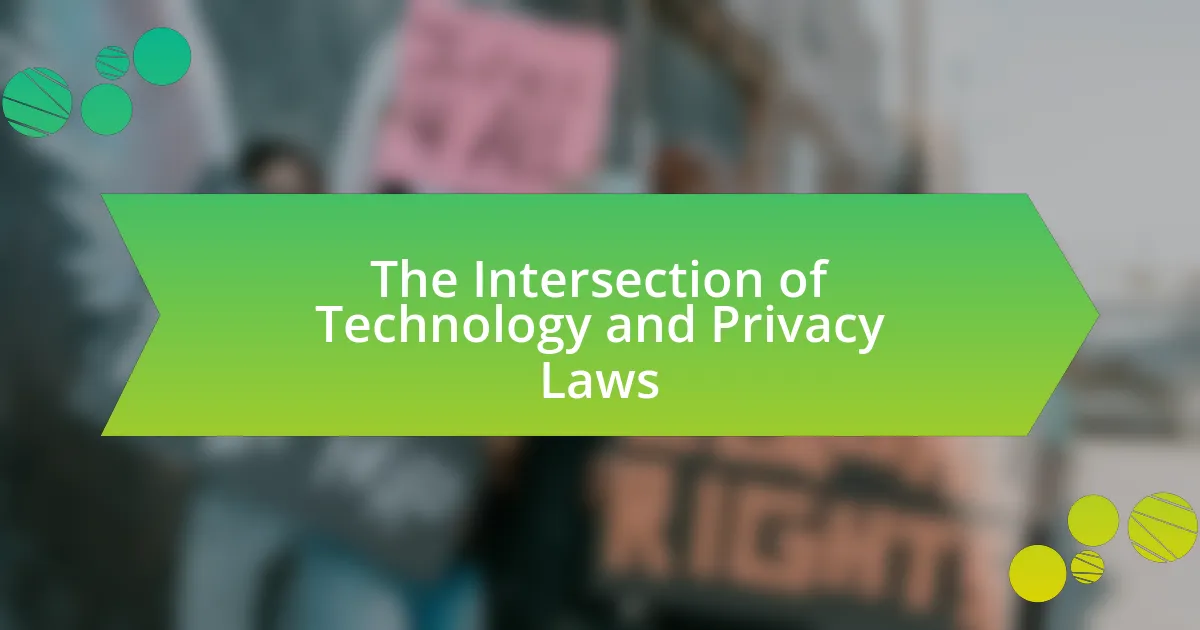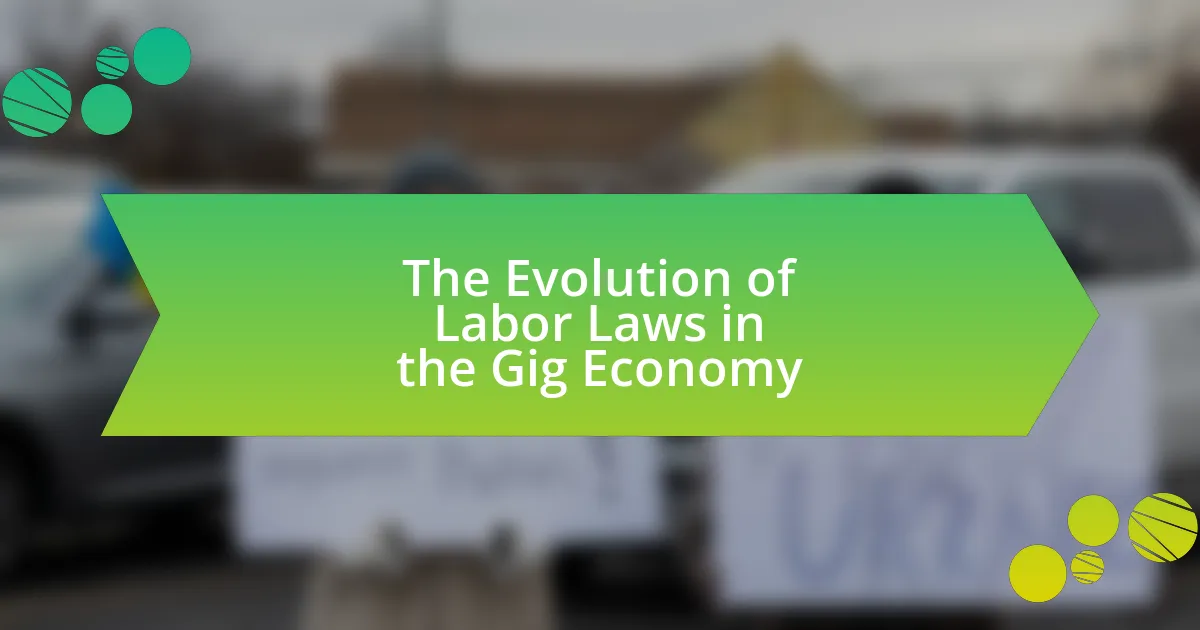The article examines the evolving landscape of immigration policies worldwide, highlighting current trends such as increased restrictions, enhanced border security, and a focus on skilled labor migration. It discusses how global events, economic factors, and political climates shape these policies, alongside the challenges faced by immigration systems today. The piece also explores the implications of demographic shifts, technological advancements, and the role of advocacy groups in influencing future immigration strategies. Key recommendations for governments include adopting inclusive policies, fostering international cooperation, and ensuring fair immigration processes to address the complexities of migration in a changing world.
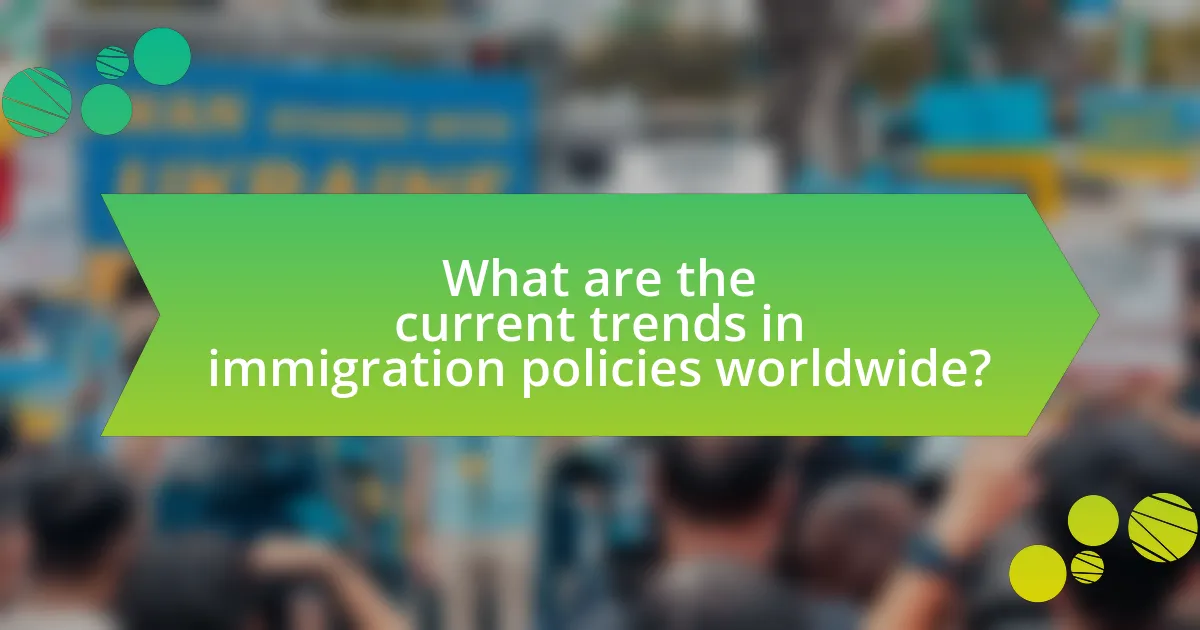
What are the current trends in immigration policies worldwide?
Current trends in immigration policies worldwide include a shift towards more restrictive measures, increased focus on border security, and the implementation of pathways for legal migration. Many countries are tightening their immigration laws in response to rising nationalism and public concerns about security and economic impact. For example, the United States has seen a significant reduction in refugee admissions and stricter asylum processes under recent administrations. Additionally, the European Union has emphasized stronger border controls and agreements with non-EU countries to manage migration flows. Data from the International Organization for Migration indicates that global migration policies are increasingly prioritizing skilled labor migration while limiting family reunification options. These trends reflect a broader global movement towards managing immigration through stricter regulations and targeted programs.
How are global events influencing immigration policies?
Global events significantly influence immigration policies by prompting governments to adapt their regulations in response to crises, economic shifts, and geopolitical changes. For instance, the Syrian civil war led to an influx of refugees in Europe, resulting in countries like Germany implementing more open immigration policies to accommodate asylum seekers. Similarly, the COVID-19 pandemic caused many nations to tighten borders and impose travel restrictions, reshaping immigration processes and prioritizing public health. These adaptations reflect how immediate global circumstances directly impact national immigration strategies, demonstrating a responsive relationship between global events and policy formulation.
What role do economic factors play in shaping immigration policies?
Economic factors significantly influence immigration policies by determining labor market needs and economic growth objectives. Countries often adjust their immigration laws to attract skilled workers who can fill labor shortages, thereby enhancing productivity and economic development. For instance, the United States has implemented programs like H-1B visas to attract high-skilled professionals in technology and engineering sectors, reflecting the demand for talent in a competitive economy. Additionally, economic downturns can lead to stricter immigration policies as governments prioritize job security for citizens, evidenced by the tightening of immigration regulations during the 2008 financial crisis. Thus, economic conditions directly shape the framework and flexibility of immigration policies to align with national interests.
How do political climates affect immigration regulations?
Political climates significantly influence immigration regulations by shaping government policies and public attitudes toward immigrants. For instance, during periods of political conservatism, countries often implement stricter immigration controls, as seen in the United States under the Trump administration, which enacted measures like the travel ban and reduced refugee admissions. Conversely, more liberal political climates tend to promote inclusive immigration policies, as evidenced by Canada’s welcoming stance towards refugees and immigrants under Prime Minister Justin Trudeau. These shifts in policy reflect broader societal attitudes and political agendas, demonstrating that immigration regulations are closely tied to the prevailing political environment.
What are the key challenges facing immigration systems today?
The key challenges facing immigration systems today include increased political polarization, resource constraints, and the impact of global crises such as pandemics and climate change. Political polarization has led to inconsistent policies and public sentiment, complicating the implementation of effective immigration strategies. Resource constraints, including funding and personnel shortages, hinder the ability of immigration agencies to process applications efficiently and fairly. Additionally, global crises exacerbate migration pressures, as seen during the COVID-19 pandemic, which disrupted travel and highlighted vulnerabilities in existing systems. These challenges necessitate comprehensive reforms to create more resilient and adaptive immigration frameworks.
How does public opinion impact immigration policy decisions?
Public opinion significantly impacts immigration policy decisions by influencing lawmakers and shaping the political landscape. When a majority of the population expresses strong views on immigration, whether in favor or against, elected officials often respond by aligning their policies with these sentiments to secure votes and maintain public support. For instance, surveys conducted by the Pew Research Center indicate that public attitudes toward immigration can lead to legislative changes, as seen in the shifts in policy during election cycles where immigration was a key issue. Additionally, political parties may adjust their platforms based on public opinion trends, further demonstrating the direct correlation between societal views and immigration policy outcomes.
What legal hurdles do immigrants face in various countries?
Immigrants face various legal hurdles in different countries, including restrictive visa policies, lengthy application processes, and stringent residency requirements. For instance, in the United States, immigrants often encounter challenges such as the complex immigration system, which includes multiple visa categories and quotas that can lead to long waiting periods. In the European Union, countries like Hungary and Poland have implemented strict border controls and asylum policies that limit the ability of immigrants to seek refuge. Additionally, many nations impose legal barriers related to employment, such as requiring work permits that can be difficult to obtain. These hurdles are often compounded by language barriers and lack of access to legal assistance, making it challenging for immigrants to navigate the legal landscape effectively.

What potential changes can we expect in immigration policies?
Potential changes in immigration policies may include increased restrictions on legal immigration pathways, as evidenced by recent trends in various countries tightening visa requirements and enhancing border security measures. For instance, the United States has seen a shift towards more stringent vetting processes and a reduction in refugee admissions, reflecting a broader global trend where nations prioritize national security and economic interests over open immigration policies. Additionally, there may be a rise in temporary work visa programs aimed at addressing labor shortages in specific sectors, as seen in countries like Canada, which has expanded its Express Entry system to attract skilled workers. These changes are often influenced by economic conditions, public sentiment, and political pressures, indicating a dynamic landscape for future immigration policies.
How might technological advancements influence immigration processes?
Technological advancements significantly influence immigration processes by streamlining application procedures and enhancing data management. For instance, the implementation of artificial intelligence in processing visa applications can reduce processing times and improve accuracy, as evidenced by the U.S. Citizenship and Immigration Services’ use of AI to analyze applications more efficiently. Additionally, biometric technologies, such as facial recognition and fingerprint scanning, enhance security and expedite border control, as seen in various countries adopting automated border control systems. These advancements not only facilitate faster and more secure immigration but also enable governments to better track and manage immigration flows, ultimately shaping future immigration policies.
What innovations are being implemented in immigration systems?
Innovations being implemented in immigration systems include the use of artificial intelligence for processing applications, blockchain technology for secure record-keeping, and biometric identification for enhanced security. These advancements streamline application processes, reduce fraud, and improve the efficiency of border control. For instance, AI algorithms can analyze vast amounts of data to expedite decision-making, while blockchain ensures that immigration records are tamper-proof and easily accessible. Additionally, biometric systems, such as facial recognition, enhance security measures at entry points, allowing for quicker and more accurate identification of individuals.
How can technology improve the efficiency of immigration applications?
Technology can improve the efficiency of immigration applications by automating data processing and enhancing communication between applicants and immigration authorities. Automation reduces the time required for data entry and verification, allowing for quicker processing of applications. For instance, the use of artificial intelligence can analyze applications for completeness and flag inconsistencies, which streamlines the review process. Additionally, online platforms enable real-time updates and communication, reducing delays caused by traditional mail or in-person visits. According to a report by the International Organization for Migration, implementing digital solutions can cut processing times by up to 50%, demonstrating the significant impact of technology on immigration efficiency.
What are the implications of demographic shifts on immigration policies?
Demographic shifts significantly influence immigration policies by altering the labor market needs and cultural dynamics of a nation. As populations age and birth rates decline in many developed countries, there is an increasing demand for younger workers to support economic growth and sustain social welfare systems. For instance, the United Nations projects that by 2050, the global population aged 60 and older will reach 2.1 billion, prompting countries like Germany and Japan to adjust their immigration policies to attract skilled labor from abroad. Additionally, changing demographics can lead to shifts in public opinion regarding immigration, as diverse populations may foster both acceptance and resistance, impacting policy formulation. Thus, demographic trends necessitate responsive immigration strategies that align with economic and social realities.
How do aging populations affect labor immigration needs?
Aging populations increase labor immigration needs due to a shrinking workforce and rising demand for healthcare and social services. As the proportion of elderly individuals grows, countries face labor shortages in various sectors, particularly in caregiving and healthcare, which require more workers to support the aging demographic. For instance, the United Nations projects that by 2050, the global population aged 60 and older will reach 2.1 billion, significantly impacting labor markets. Consequently, nations may implement more favorable immigration policies to attract foreign workers, ensuring that essential services remain adequately staffed and the economy continues to function effectively.
What impact do youth migration trends have on policy formulation?
Youth migration trends significantly influence policy formulation by prompting governments to adapt their immigration strategies to address the needs and challenges associated with a younger demographic. As youth migration increases, policymakers recognize the necessity to create frameworks that facilitate integration, support education, and enhance employment opportunities for young migrants. For instance, the United Nations reports that approximately 30% of international migrants are aged 15 to 29, highlighting the importance of tailoring policies to this age group. This demographic shift compels countries to consider factors such as skills matching, labor market demands, and social inclusion in their immigration policies, ensuring that they remain relevant and effective in a rapidly changing global landscape.
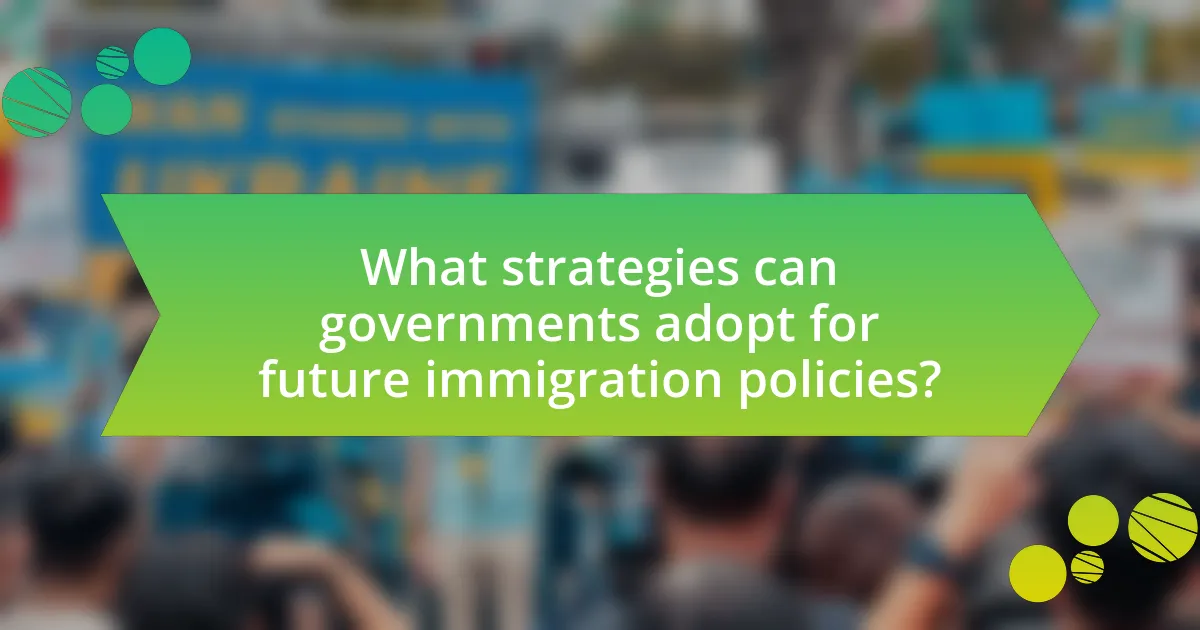
What strategies can governments adopt for future immigration policies?
Governments can adopt a multi-faceted approach to future immigration policies by implementing targeted skill-based immigration systems. These systems prioritize immigrants with skills that meet labor market demands, which can enhance economic growth and address skill shortages in various sectors. For instance, countries like Canada have successfully utilized point-based systems that assess candidates based on education, work experience, and language proficiency, leading to a more efficient integration of immigrants into the workforce. Additionally, governments can establish pathways for temporary workers to fill immediate labor gaps while ensuring that these workers have rights and protections. This strategy not only addresses short-term economic needs but also fosters a more inclusive society. Furthermore, enhancing collaboration with international organizations can help manage migration flows and ensure that policies are humane and respect human rights, as seen in the Global Compact for Migration adopted by the United Nations in 2018.
How can countries balance security and humanitarian needs in immigration?
Countries can balance security and humanitarian needs in immigration by implementing comprehensive policies that integrate border security measures with humanitarian protections. For instance, nations can enhance screening processes to identify security threats while simultaneously ensuring that asylum seekers receive fair and timely assessments of their claims. Research from the International Organization for Migration indicates that countries employing a dual approach—strengthening border controls while providing legal pathways for refugees—can effectively manage migration flows without compromising safety. This strategy not only addresses security concerns but also upholds international obligations to protect vulnerable populations, demonstrating that security and humanitarian needs can coexist through well-designed immigration frameworks.
What best practices can be implemented to ensure fair immigration processes?
To ensure fair immigration processes, implementing transparent criteria for visa applications is essential. Clear guidelines help applicants understand the requirements and reduce ambiguity, which can lead to inconsistencies in decision-making. For instance, countries like Canada utilize a points-based system that evaluates applicants based on specific criteria such as education, work experience, and language proficiency, promoting fairness and objectivity. Additionally, regular training for immigration officials on cultural sensitivity and bias reduction can enhance equitable treatment of applicants. Research indicates that bias in decision-making can significantly affect outcomes; therefore, training programs can mitigate these biases, ensuring that all applicants are assessed fairly.
How can international cooperation enhance immigration policy effectiveness?
International cooperation can enhance immigration policy effectiveness by facilitating the sharing of best practices, resources, and data among countries. Collaborative frameworks, such as bilateral agreements and multilateral organizations, enable nations to address common challenges like human trafficking and irregular migration more efficiently. For instance, the Global Compact for Safe, Orderly and Regular Migration, adopted by the United Nations in 2018, emphasizes the importance of international collaboration in managing migration flows and protecting migrants’ rights. This cooperative approach leads to more comprehensive and cohesive immigration policies that can adapt to global trends and improve outcomes for both migrants and host countries.
What role do advocacy groups play in shaping future immigration policies?
Advocacy groups play a crucial role in shaping future immigration policies by influencing public opinion and legislative processes. These organizations mobilize communities, conduct research, and provide expert testimony to policymakers, thereby highlighting the social, economic, and humanitarian aspects of immigration. For instance, groups like the American Civil Liberties Union (ACLU) and the National Immigration Law Center (NILC) have successfully lobbied for reforms that protect immigrant rights and promote pathways to citizenship. Their efforts often result in increased awareness and support for policies that reflect the needs and rights of immigrant populations, as evidenced by the significant public support for the Deferred Action for Childhood Arrivals (DACA) program, which was largely driven by advocacy efforts.
How can public engagement influence policy changes?
Public engagement can significantly influence policy changes by providing a platform for citizens to express their needs and opinions, which policymakers can then consider in their decision-making processes. For instance, public consultations and town hall meetings allow community members to voice their concerns about immigration policies, leading to adjustments that reflect the population’s priorities. Research indicates that when citizens actively participate in policy discussions, such as through surveys or advocacy campaigns, there is a higher likelihood of policy alignment with public sentiment, as seen in the 2017 immigration reform debates in various countries where public opinion shifted policy proposals.
What strategies can be employed to promote inclusive immigration policies?
To promote inclusive immigration policies, governments can implement community engagement initiatives that foster dialogue between immigrants and local populations. Such strategies include establishing advisory councils that include immigrant representatives, which can help ensure that policies reflect the needs and perspectives of diverse communities. Research indicates that inclusive policies can lead to better integration outcomes; for instance, a study by the Migration Policy Institute found that cities with strong immigrant engagement programs experience lower rates of social tension and higher economic contributions from immigrant populations.
What are the best practices for adapting to changing immigration landscapes?
To adapt to changing immigration landscapes, organizations and policymakers should prioritize flexibility, continuous monitoring of policy changes, and stakeholder engagement. Flexibility allows for quick adjustments to new regulations or shifts in public sentiment, ensuring compliance and responsiveness. Continuous monitoring of immigration policies, such as tracking legislative changes and demographic trends, enables proactive strategies. Engaging stakeholders, including immigrant communities and advocacy groups, fosters collaboration and ensures that policies reflect diverse needs. These practices are supported by research indicating that adaptive governance improves policy effectiveness in dynamic environments.
